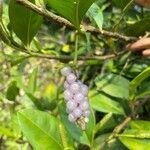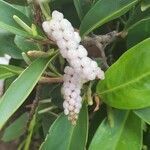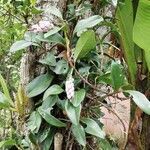Plants epiphytic, the caudices elongate, often branched, becoming suffrutescent, rather stiff, usually emitting many long roots from the nodes, the internodes short or elongate, usually covered by fibrous remains of the cataphylls; petioles slender or rather stout, one-fifth to one-half as long as the blades, dilated at the base, geniculate near the apex and slightly dilated; blades subcoriaceous when dried, densely punc-tate beneath, lanceolate to oblong-lanceolate or sometimes lance-ovate, mostly 4.5-9 cm. long and 2-4 cm. wide, acuminate to subobtuse, acute at the base or rarely obtuse or rounded, the primary lateral nerves numerous, very slen-der, prominent beneath but not conspicuous, united to form a distinct but slender collective nerve near the margin; peduncles slender, equal-ing or slightly exceeding the petioles; spathe green or pale green, lanceolate or oblong-lanceo-late, usually 2.5 cm. long or less, cuspidate, reflexed; spadix sessile or nearly so, in anthesis about 2 cm. long, very obtuse, in fruit often 4.5 cm. long; berries globose, usually lavender or pale purple, some-times white, about 5 mm. in diameter.
More
A vine that grows attached to other plants or on rocks. It climbs by roots that attach to other plants and it grows 1-2 m long. The stems hang down. There is a fibrous sheath between the nodes. The leaves are simple and alternate. The leaf blades are narrowly oval to sword shaped and 8-13 cm long by 3-5 cm wide. The flowering groups are erect in the axils of the leaves. The flower spadix is 1-2 cm long. There is a spathe around the flower that curves back. The fruit are flattened berries. They are 5 mm across. They are juicy and white when ripe. The seeds are 1 mm long.



